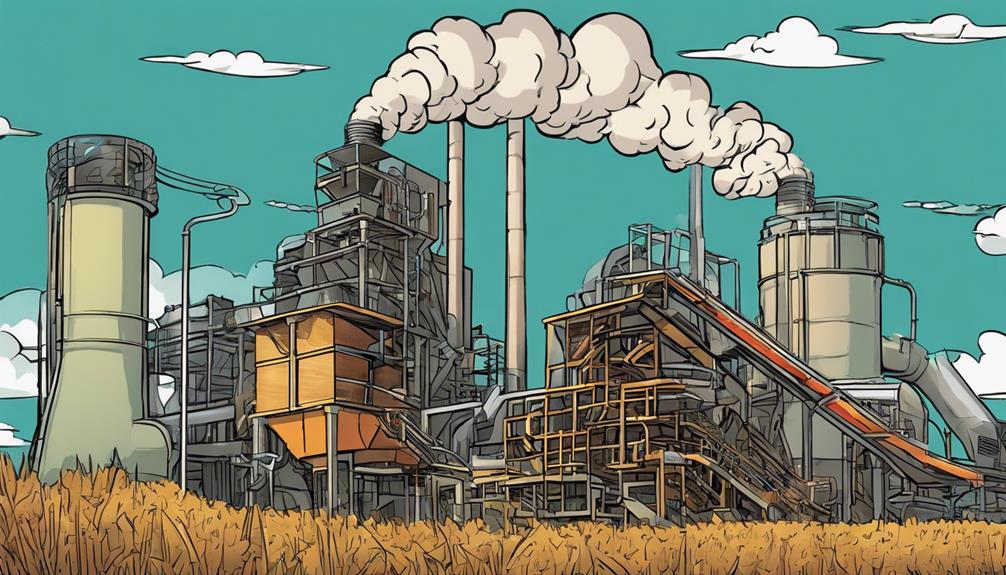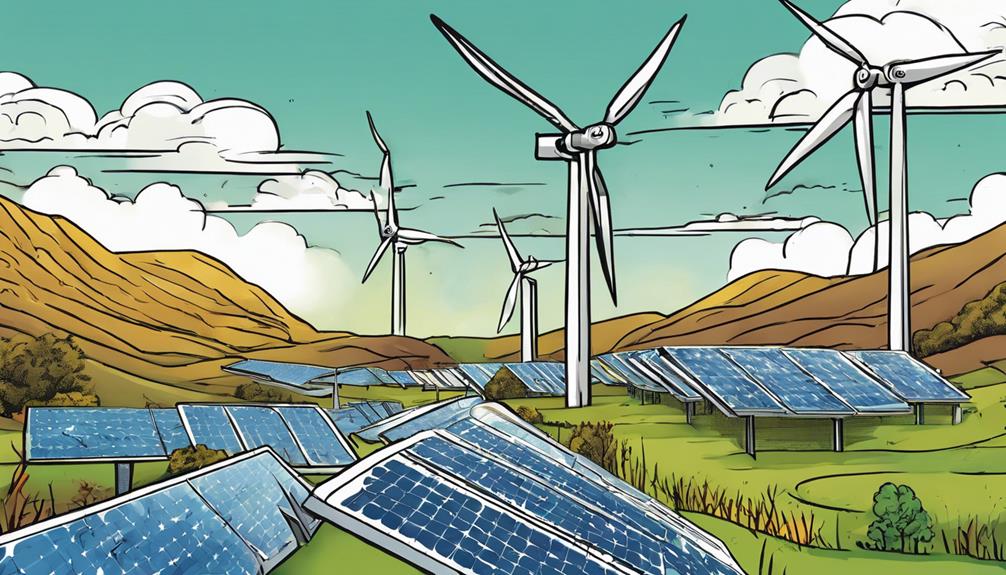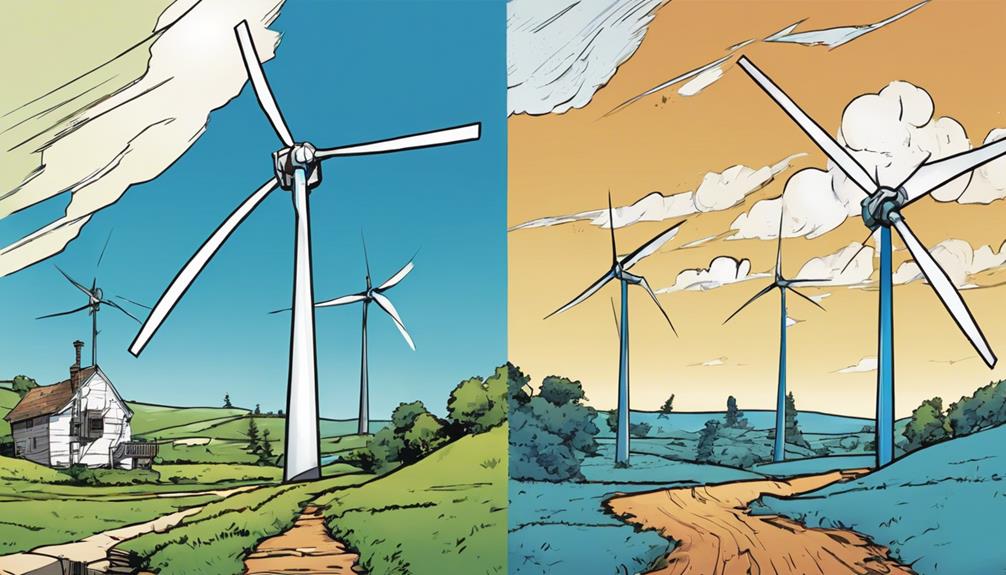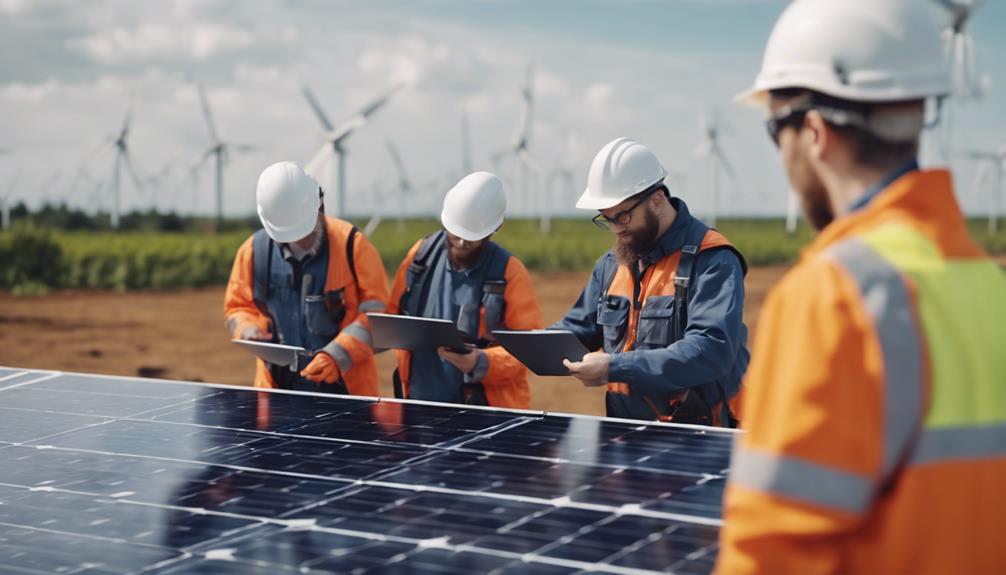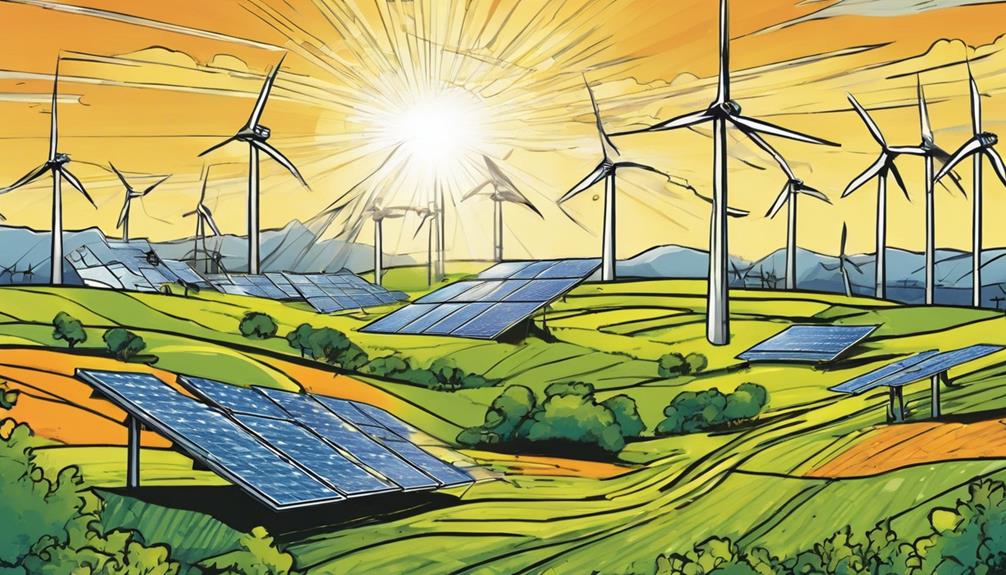To produce electricity from biomass, you can burn organic materials in combustion, using the heat to create steam that powers a turbine connected to a generator. Another method is gasification, where controlled heat turns biomass into syngas for electricity. Anaerobic digestion decomposes organic waste to produce methane that can generate power. These processes help in sustainable energy production and reducing greenhouse gas emissions. If you want to learn more about the specific advantages and challenges of biomass electricity generation, there are further details available on the various methods and benefits.
Key Takeaways
- Biomass combustion generates power by burning organic materials to produce steam for electricity.
- Gasification converts biomass into syngas, utilized in gas turbines or fuel cells for electricity.
- Pyrolysis produces bio-oil for electricity generation.
- Anaerobic digestion converts organic waste into biogas, used for electricity production.
- Co-firing biomass with coal enhances renewable energy production and reduces emissions.
Combustion for Electricity Generation
Biomass combustion for electricity generation involves burning organic materials like wood, agricultural residues, and waste to produce power efficiently. This process harnesses the chemical energy stored in biomass through direct combustion, wherein organic materials are burned to create heat.
The heat produced is then used to boil water and generate steam, which drives a steam turbine connected to a generator. Most biomass power plants utilize this method due to its simplicity and effectiveness in converting biomass into electricity.
Additionally, co-firing biomass with coal in existing power plants has become a prevalent practice to enhance renewable energy production and reduce greenhouse gas emissions simultaneously. This process not only contributes to the diversification of energy sources but also aids in achieving renewable energy goals.
Gasification Process Overview

In the gasification process, biomass is heated in controlled conditions to produce syngas and biochar. Syngas, a versatile energy-rich gas consisting of carbon monoxide, hydrogen, and other gases, plays a pivotal role in biomass conversion for electricity generation.
Gasification enables the efficient utilization of biomass resources, offering a more advanced and efficient method compared to traditional combustion processes. The syngas generated through gasification can be utilized in various energy systems like gas turbines, engines, or fuel cells to produce electricity.
This advanced method not only enhances the electricity generation process but also contributes to sustainable energy practices by converting biomass into a valuable energy source. By optimizing the controlled conditions in gasification, the production of syngas and biochar from biomass can be further improved, making it a promising avenue for enhancing the overall efficiency of biomass electricity production.
Anaerobic Digestion for Power Production

To harness power through anaerobic digestion, organic waste undergoes decomposition by bacteria in oxygen-free conditions to produce methane for electricity generation.
This methane can be further purified into renewable natural gas, offering a sustainable energy source.
Anaerobic digestion presents a green solution to convert organic waste like manure and food scraps into biogas, contributing to electricity production.
Additionally, this process aids in reducing greenhouse gas emissions by capturing methane, thereby mitigating environmental impacts.
By utilizing anaerobic digestion for power generation, we can foster a circular economy by repurposing waste into energy and lessen our dependence on fossil fuels.
Embracing this eco-friendly method not only helps in sustainable electricity production but also plays a crucial role in combatting climate change.
With anaerobic digestion, we not only address waste management but also move towards a cleaner and more efficient energy future.
Biomass Electricity Benefits and Challenges

You'll discover the benefits of biomass electricity, such as its role in reducing greenhouse gas emissions and supporting local economies.
However, challenges like high initial costs and the necessity for consistent biomass supply must be addressed to guarantee sustainable power generation.
Technological advancements are vital to enhance efficiency and competitiveness in the renewable energy sector.
Benefits of Biomass Electricity
What advantages does biomass electricity offer for sustainability and economic development?
Biomass electricity, as a renewable energy source, plays a significant role in reducing greenhouse gas emissions compared to fossil fuels. By utilizing biomass feedstock such as organic waste or dedicated energy crops, this form of energy production helps mitigate environmental impacts and promotes sustainable practices.
In addition to its green credentials, biomass electricity contributes to economic development by providing a reliable energy supply and creating job opportunities in rural areas where biomass resources are abundant. Despite facing challenges like managing air pollution and enhancing technology efficiency, biomass electricity offers long-term benefits that outweigh the initial investment costs.
Moreover, in the larger context of shifting towards a more sustainable energy mix, biomass electricity stands as a pivotal player alongside other renewable energy sources in ensuring a cleaner and greener future.
Challenges in Biomass Generation
As we explore the challenges in biomass electricity generation, it's important to address the high initial investment costs and the availability and consistency of biomass feedstock.
Here are some key challenges in biomass generation:
- High Initial Investment Costs: Setting up biomass power plants requires significant capital investment for equipment and infrastructure.
- Availability and Consistency of Biomass Feedstock: The supply of biomass can be inconsistent, affecting the continuous operation of biomass power plants.
- Concerns about Air Pollution and Emissions: The combustion process in biomass power plants can produce pollutants and greenhouse gases.
- Competition with Other Renewable Energy Sources: Biomass electricity faces competition from sources like solar and wind energy, impacting its market share.
Addressing these challenges requires advancements in technology for efficient conversion of biomass into power and heat, ensuring a reliable and sustainable fuel source for generating electricity.
Biomass Conversion Methods Explained

To understand biomass conversion methods in electricity production, it's essential to grasp the various techniques involved, including combustion, gasification, pyrolysis, and anaerobic digestion.
Solid biomass is subjected to different processes to create energy. Combustion involves burning biomass in a boiler, producing steam to drive a turbine for electricity generation.
Gasification heats biomass at high temperatures with limited oxygen, creating syngas used as fuel for electricity.
Pyrolysis heats biomass without oxygen, producing bio-oil that can substitute fuel oil or diesel in electricity generation.
Anaerobic digestion decomposes organic waste with bacteria to produce methane, which is then used to generate electricity.
Each method plays a crucial role in converting biomass into sustainable energy sources, ensuring a diverse range of options for electricity generation from renewable resources.
Biomass Electric Generation in Canada

Exploring biomass electric generation in Canada reveals its significant contribution to the country's renewable energy portfolio, particularly in provinces like British Columbia, Ontario, Quebec, Alberta, and New Brunswick. Here are some key facts about biomass electricity generation in Canada:
- Biomass accounts for 1.4% of Canada's electricity and is the third largest renewable source in the country.
- Electricity from biomass in Canada increased by 54% from 2005 to 2015, showcasing its growing importance in the energy sector.
- Most biomass power plants in Canada are located in British Columbia, Ontario, Quebec, Alberta, and New Brunswick.
- Biomass electricity generation supports local economies and job creation in rural areas across Canada.
The utilization of biomass materials and feedstocks for generating electricity plays an essential role in diversifying Canada's energy mix and reducing dependence on fossil fuels.
With the presence of biomass power plants in key provinces, Canada demonstrates a commitment to sustainable energy practices within the renewable energy sector.
Frequently Asked Questions
How Is Biomass Electricity Transported?
To transport biomass electricity, power lines are utilized, just like with other sources. It's integrated into the existing grid for distribution. Grid operators manage the flow to guarantee a reliable supply, utilizing advanced technologies for optimization.
How Is Biomass the Best Energy Source?
As the top energy source, biomass shines for its renewability, sustainability, and emission reduction benefits. Its reliable feedstock availability from wood, residues, and waste makes it a solid choice. Rural job creation and economic support add to its appeal.
How Does Biomass Power Plant Waste to Energy?
To turn waste into energy, biomass power plants utilize processes like direct combustion, gasification, pyrolysis, and anaerobic digestion. Organic materials such as wood, agricultural residues, and waste are converted into electricity, contributing to sustainable power generation.
Can Biofuels Be Used to Generate Electricity?
So, you're wondering if biofuels can make electricity? Absolutely! They burn or convert into gases that spin turbines. It's like magic, but greener. Embrace biofuels for cleaner, renewable power. Join the eco-friendly energy revolution!
What role does biomass play in the transition to renewable energy for a sustainable future?
Biomass has a crucial role in transitioning to renewable energy steps. It involves using organic materials like wood, crops, and waste to produce bioenergy. By utilizing biomass, we can reduce our reliance on fossil fuels and move towards a more sustainable future by generating clean, renewable energy.
Conclusion
Now that you've learned about the various ways biomass can produce electricity, you can see the potential for a greener future.
From combustion to gasification, there are innovative methods to harness the power of biomass.
Despite challenges, the benefits of biomass electricity generation are clear.
So, next time you turn on a light, think about the sustainable energy behind it.
The possibilities are endless when we choose to embrace renewable resources.
